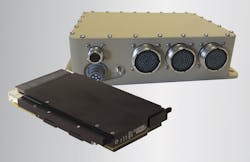Wanted: rugged atomic clock for military positioning, navigation, and timing (PNT) in communications and EW
ARLINGTON, Va. – U.S. military researchers are asking industry to develop a rugged, high-stability, and compact optical atomic clock that fits into a standard 3U electronics enclosure and outputs a standard timing signal to improve military positioning, navigation, and timing (PNT).
Officials of the U.S. Defense Advanced Research Projects Agency (DARPA) in Arlington, Va., issued a Small Business Innovation Research (SBIR) opportunity on Monday for the Prototype Optical Frequency Standard project.
DARPA researchers want an integrated product-ready atomic clock prototype that resists the effects of vibration that is sized between the highly compact clocks currently under development for near-term commercialization, and the high stability optical atomic clocks found in research laboratories that will not be commercial-ready for a long time.
These kinds of high accuracy clocks would be critical components of military PNT systems for communications, navigation, reconnaissance, and electronic warfare (EW), as well as for commercial communications, distributed computing, petrochemical exploration, and scientific research.
Atoms form the basis for the most stable timekeeping systems, DARPA experts explain. Over the last decades, many rugged atomic clock concepts have been developed and either commercialized or prototyped as unique systems for general use.
Experts have made recent progress in developing atomic clock systems smaller than one liter in volume and Allan Deviation (ADEV) accuracy of 10-13 @ 100,000 s. This kind of technology is entering the prototype stage on the DARPA Atomic Clock with Enhanced Stability (ACES) program, while the foundations of portable and larger clocks with higher accuracy are being developed on the DARPA Atomic-Photonic Integration (A-PhI) program.
Still, there remains a need for optical atomic clocks with sizes and accuracy that bridge the two extremes. Enabling technologies already have been developed in appropriate size and the photonics to translate the atomic optical frequency into an output that electronic equipment can use. The Prototype Optical Frequency Standard project seeks to incorporate these components into a prototype atomic clock.
The project's first phase have demonstrated a design for the compact clock system. The second phase will create a clock prototype based on first-phase design. Novel techniques are not encouraged unless they result in meaningful simplifications to the design, such as reducing the number of lasers or critical components required.
Related: DARPA eyes photonic integrated circuits for non-GPS position, navigation, and timing (PNT)
Two prototypes must be created -- one to be delivered to the government for independent verification, and the other with internal hardware, but is not required to be packaged. The second phase also will subject prototypes to environmental conditions such as vibration sensitivity.
Companies interested should submit proposals no later than 20 April 2021 at https://www.sbir.gov/content/submission-proposals.
Email questions or concerns to [email protected]. More information is online at https://beta.sam.gov/opp/3311543c53534aec9f3c0c84c9c761ea/view.
About the Author
John Keller
Editor-in-Chief
John Keller is the Editor-in-Chief, Military & Aerospace Electronics Magazine--provides extensive coverage and analysis of enabling electronics and optoelectronic technologies in military, space and commercial aviation applications. John has been a member of the Military & Aerospace Electronics staff since 1989 and chief editor since 1995.
